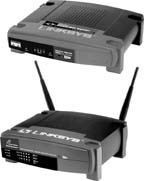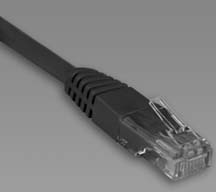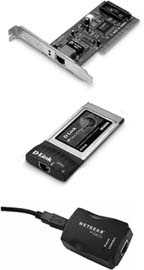Sure, there are a heck of a lot of products in the networking aisle down at Big Giant Computer Store, but don't be overwhelmed. Planning a home network is a lot like picking the types of telephones you need when you're moving into a new home: you can choose between old-fashioned landlines and snazzy wireless cellphones, corded and cordless handsets, speakerphones and headsets. Nowadays, you can even get walkie-talkie features or the ability to make calls over the Internet. But, thankfully, in order to choose from this smorgasbord of options, you don't need to know anything about the phone system's underlying technology. You do, however, need to understand some telephone basics, like the fact that you don't need to have a phone jack in every room if you're going to go the cordless phone route.
Home networks are a lot like phones in that you don't need to understand the gory details of how computers talk to each other—but you do need to know what equipment makes sense for your situation. For example, if you want to be able to surf the Web while sitting next to your pool, wireless networking—also known as WiFi—will save you from running 30 feet of ugly cable out your back door. But if you've got only two desktop computers in your home office, a small wired network is probably your best bet. This chapter explains the main components of a home network, a few variations on the theme, and how to decide what's best for you.
To set up a home network, you need three things (beside computers, electricity, and a little bit of moxie):
A router. This device distributes your cable or DSL (digital subscriber line) Internet connection to the computers on your network. It's like the clerk at the train station giving everyone on your network a ticket to ride. Figure 1-1 shows a picture of both a wired and wireless router. .
Figure 1-1. Whether they're wired (top) or wireless (bottom), your network's router keeps the traffic moving along your network and divvies up that high-speed cable or DSL connection, distributing it from your Internet service provider to all the computers connected to your home network. Routers designed for wired networks typically have jacks on the back so that they can connect (via network cables) to a modem and all the PCs that are on the network. Wireless routers, on the other hand, have jacks to hook up to your broadband modem and maybe one other network device. But wireless routers use invisible radio waves to connect to PCs that are within range.
You connect the router to your cable or DSL modem with a cable, and, depending on the kind of equipment you choose, you connect your individual computers to the router either with cables or using wireless technology.
Note
It's possible to set up a home network that doesn't use a router and simply links all your computers to each other to share files. But since one of the biggest reasons to set up a home network is to share a high-speed broadband connection among several computers, the heart of most home networks is the router.
Cables or wireless signals. Whether they're colorful strands of plastic-coated cable (Figure 1-2) or invisible radio waves (not shown, because invisible doesn't photograph so well), these are ways you connect your computers to the network.
Figure 1-2. Computer network cable is available in varying lengths and many festive colors from most computer stores. You need one cable for every computer you want to connect to your network. You should also make sure the cable is long enough to reach the router. Chapter 2 tells you everything you need to know about picking out the right type of cable.
Network adapters. This term is really just a fancy name for the jack on the back (or side) of your computer where you'll plug in your cables or exchange wireless signals. You need one of these doodads on all the computers and devices (such as a printer) that you want to add to your network.
Way back in the 1990s, having a computer with a network jack already installed was a rare, beautiful, and expensive thing. These days, network jacks (and sometimes even wireless network adapters) typically come standard on new machines. In fact, you'd be hard pressed today to find any computer for sale without a wired network adapter, which is also known as an Ethernet connection or Ethernet port. Wireless network adapters—usually called WiFi cards—are increasingly standard on laptops, and you can add them to any computer (Section 3.3.4).
There are three kinds of network adapters, as shown in Figure 1-3, each of which connects to a computer in a different way:
A Peripheral Component Interconnect (or PCI) card plugs into the motherboard (a circuit board inside the computer). The card endows your computer with a connection jack that peeks outside the PC's case.
A USB adapter plugs into the USB port on any kind of computer and parks itself on the outside of your machine. (See the box "Catching the Universal Serial Bus" on Section 1.2.)
A PC card plugs into a special slot on laptops.
Figure 1-3. Network adapters for the computer come in all shapes and sizes. Top: This PCI card plugs into a slot inside the computer and provides one Ethernet jack for connecting a network cable. (You need to open up your computer's case to install one of these.) Middle: PC cards work with laptop computers. The card plugs right into the PCMCIA slot and supplies an Ethernet jack for a wired network connection. (You can also get similar-looking cards to use with a wireless network.) Bottom: This USB adapter plugs into the computer's USB port and saves you the trouble of wrestling the machine apart to install a network card. USB adapters can be quite convenient but require the full-time use of one of your computer's USB ports.
Note
If your computer doesn't have a network adapter at all or if you want to install a wireless adapter, take a stroll to Section 2.1.3.
As if the term "network adapter" weren't geeky enough, the electronics industry also calls these devices network cards, Network Interface Cards (or NIC), and Ethernet adapters, to name a few possibilities—all adding to the swirling mess of nerd words now inside your head. Despite the intimidating names, they're all just jacks for your network cables or receiving points for wireless signals.
That's it. You just need three basic pieces of hardware to build a rollicking network to make everyone in the house incredibly happy. "Okay," you say to yourself. "'Three pieces of hardware' sounds pretty easy."
But what about software?
Get Home Networking: The Missing Manual now with the O’Reilly learning platform.
O’Reilly members experience books, live events, courses curated by job role, and more from O’Reilly and nearly 200 top publishers.




